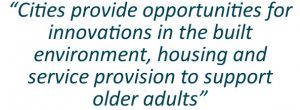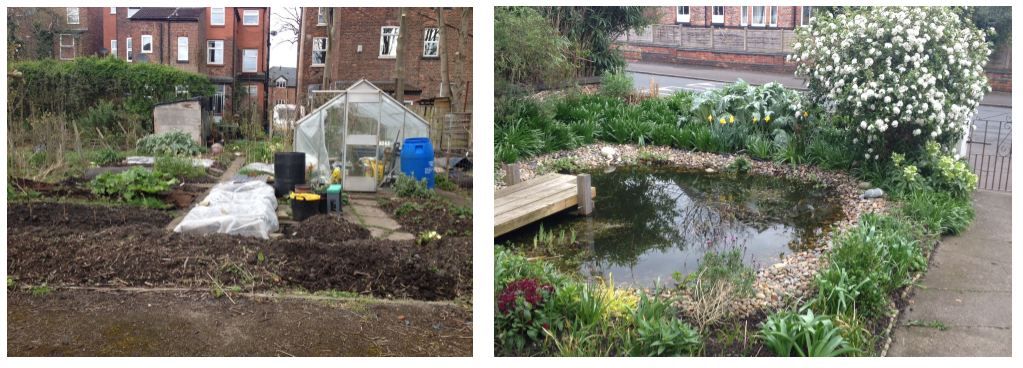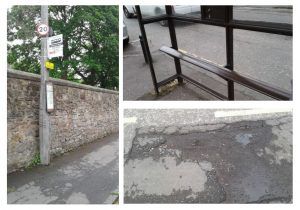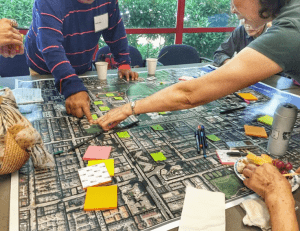As we continue our look at inclusive approaches to community empowerment, Professors Ryan Woolrych and Judith Sixsmith highlight the key challenges and considerations for designing urban environments for and with older people. This draws on their current cross-national research which seeks to understand the lived experiences of older adults residing in cities in the UK and Brazil.
Two dominant social trends are driving what happens within our cities – population ageing and increasing urbanisation. By 2030 two-thirds of the population will be living in cities. At least a quarter of those urban populations will be aged 60 plus. Developing urban environments that support and promote healthy living for older people has become a key driver of urban policy and interventions at a local and national level.
 The ageing-in-place agenda suggests the preferred environment to age is at home and in the community. This is providing older adults can retain a sense of independence, safety and security. The ability to remain at home depends on having ‘assets and resources’ to support healthy ageing, e.g. access to transport, adequate housing, healthcare services, and leisure opportunities alongside social networks and opportunities for lifelong learning. In this respect, cities provide opportunities in terms of the space for innovations in the built environment, housing and service provision to support older adults.
The ageing-in-place agenda suggests the preferred environment to age is at home and in the community. This is providing older adults can retain a sense of independence, safety and security. The ability to remain at home depends on having ‘assets and resources’ to support healthy ageing, e.g. access to transport, adequate housing, healthcare services, and leisure opportunities alongside social networks and opportunities for lifelong learning. In this respect, cities provide opportunities in terms of the space for innovations in the built environment, housing and service provision to support older adults.
Urban areas in their current form often promote a form of architectural disability largely arising from a poorly designed environment. This creates conditions for social isolation, dependency and exclusion. Cities are often marketed to a young, urban population and the lifestyles and preferences of older adults can be seen as antithetical to the bright, vibrant city. Processes of urbanisation have tended to exclude older adults – urban regeneration programmes and gentrification create sudden changes to the urban environment that can have can have a disproportionate impact on older people who often depend on their immediate community.
These issues raise important questions – how are we supporting the rights of older people to age in place? What more can be done to support active ageing amongst older people living in urban environments? How can we empower older adults to assume purposeful roles within their communities in old age?

Allotments and green spaces can support health and mental well-being in old age.
Place-making with Older People
An ESRC project Place-making with Older People is currently exploring the experiences of older adults living in three UK cities to identify how communities can be better designed to support older adults to age-in-place. Older adults have been involved closely in the research, both in an advisory capacity and in the collection of the research through walking interviews and photo diaries.
The project has identified the importance of developing a sense of place amongst older adults living in their communities. This form of belonging and identity can be created through opportunities for social participation, assuming meaningful roles in the community and having a legible, barrier-free urban environment.
Urban environments are multi-layered and require interventions at the home, street and community level. For example, a supportive home environment (inclusive design, aids and adaptations and homecare etc.) will not necessarily create the conditions for healthy ageing if that person does not have nearby community support such as amenities. Similarly, an age-friendly community with adequate transport provision will not support mobility if the older person cannot reach the transport node owing to a lack of signage, absence of benches or inadequate shelter.
Meaningful Urban Environments to Age In
Nor does the responsibility for our urban environment stop at merely providing more bus stops or expanding the width of our sidewalks. Older adults have highlighted the importance of place-keeping – the sustainability and maintenance of our urban spaces. Local cuts to services have afforded lower priority to street cleaning, pavement maintenance and the upkeep of parks and green spaces. As a result, the material aspects of urban environments have fallen into disrepair, creating hazards, undermining community pride and reducing the quality of green spaces which can normally enhance mental well-being.

Clockwise: Narrow seating without back or arm support not always suitable; Pavement maintenance can act as a fall hazard for older adults; Lack of shelter and seating at bus stops can be an impediment to mobility.
Urban environments also need to have social value. These include strong social networks at a street level such as neighbours helping with shopping, caring for the home and collecting prescriptions. They also extend to information exchange between residents within public spaces and highlight the need for spaces that bring people together. The research has also found that these social networks are reciprocated – older adults caring for other older adults, and acting as community champions in the local area, thereby challenging the ‘dependency’ label that is often associated with old age.
Older adults were asked how age-friendly communities could be developed moving forward. A priority was the need to live in communities that foster inter-generational supports. Participants were critical of housing interventions and communities which acted as ‘ghettoes for the old’ but which provided the opportunities for young and old to come together. Housing interventions need to reflect the changing requirements of older people as they age, where there are options within the community. It was not uncommon for older adults to lose close friends because of the lack of local housing supports, forcing people to move a considerable distance and breaking up social networks.
 This lack of choice reflected a deeper concern about citizenship and rights within the context of urban environments. Rights in this sense were constructed as (i) rights to access and use urban spaces and (ii) the right to have their views heard and considered in the future development of the community. Older adults reported that they are often consulted within the local community but it can seem tokenistic, one-way or their comments do not shape future design. This is surprising, not only because our participation and engagement processes are supposedly designed to be more inclusive, but because older adults should be seen and valued as the experts within our communities. Older adults often spend a lot of time in the community, have deep local knowledge and are actively seeking more active roles in the community.
This lack of choice reflected a deeper concern about citizenship and rights within the context of urban environments. Rights in this sense were constructed as (i) rights to access and use urban spaces and (ii) the right to have their views heard and considered in the future development of the community. Older adults reported that they are often consulted within the local community but it can seem tokenistic, one-way or their comments do not shape future design. This is surprising, not only because our participation and engagement processes are supposedly designed to be more inclusive, but because older adults should be seen and valued as the experts within our communities. Older adults often spend a lot of time in the community, have deep local knowledge and are actively seeking more active roles in the community.
Towards Age-Friendly Communities

Participatory mapping with older adults to design age-friendly communities.
Policy makers, practitioners and academics need to work more closely with older adults to identify barriers and facilitators to the delivery of age-friendly communities centred on achieving active ageing, social participation and independence. This will require challenging existing principles of urban planning and development that exclude older adults. We need to prototype and design solutions for age-friendly communities. These will not be generic, one-size fits all models. Old age is not homogenous and cities are diverse. Urban environments offer potential to support older adults to make a positive contribution in old age, to lead healthier as well as longer lives, and have the opportunities to flourish. Yet only if they are designed in an inclusive and equitable way.
This work was conducted as part of the ESRC-funded project Place-Making with Older Adults. Website: (http://placeage.org/en/). Twitter @placeage.
